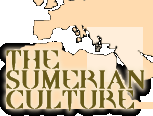 |
|
|
 |
| Sumerians
were an ancient population that lived in the south of a region
called Mesopotamia, located between the Tigris and Euphrates
rivers (Mesopotamia means 'land between two rivers'). |
 |
| What
was once Sumeria is now southern Iraq and Kuwait. |
|
|
 |
 |
HISTORY
The Sumerians probably came from the area of Anatolia, and arrived
in Mesopotamia about 3300 BC. As successful trade developed with
the surrounding areas, the Sumerian villages and settlements grew
into prosperous city-states, such as Ur, Eridu, Lagash, Nippur and
Uruk.
By the third millennium BC the Sumerians had founded about 12 separate
city-states (Kish, Erech, Ur, Sippar, Akshak, Larak, Nippur, Adab,
Umma, Lagash, Bad-tibira, and Larsa). Each of these states had a
walled city with surrounding villages and land, and each worshipped
its own deity, whose temple was at the center of the city.
The Sumerian language became the major language of the region. Political
power originally belonged to all the citizens, but as settlements
grew into city-states and rivalry between the various city-states
increased, each adopted a system of kings.
Various city-states and their dynasties of kings temporarily gained
power at different times. The first king to unite the separate city-states
was Etana, ruler of Kish (c. 2800 BC). After this, the cities of
Kish, Erech, Ur, and Lagash started to fight with each other in
order to gain power. These struggles lasted for hundreds of years
and weakened the Sumerian nation, making it vulnerable to conquerors
from abroad. First Sumeria was invaded by the Elamites (c. 2530-2450
BC) and later by the Akkadians (2334-2279 BC). Although Akkadian's
dynasty lasted only about 100 years, it united the city-states and
created a model of government that influenced all of Middle Eastern
civilization.
After Akkadian's dynasty ended and Sumeria recovered from a devastating
invasion by the Gutians, the city-states once again became independent.
The high point of this final era of Sumerian civilization was the
reign of the Third Dynasty of Ur, whose first king, Ur-Nammu, published
the earliest law code yet discovered in Mesopotamia.
After 1900 BC, when another population, the Amorites, conquered
all of Mesopotamia, the Sumerians lost their separate identity,
but their culture was adopted by their invaders. |
|
 |
 |
RELIGION
The Sumerian gods personified local elements and natural forces.
Anu (the supreme god of heaven), Enlil (god of water), and Ea (god
of magic) were among the gods most worshipped by the Sumerians.
The Sumerians held the belief that a sacred ritual marriage between
the ruler and Inanna, goddess of love and fertility, brought rich
harvests.
Religion was a central aspect of ancient Sumerian society. The city-states
were believed to be under the rule of a local god or goddess. Each
city had a temple that was the seat of a major god in the Sumerian
pantheon. The temples were large and were staffed by priests and
priestesses.
The rulers of the city had a duty to please the town's patron god.
The clergy, helped by musicians and singers, carried out the complex
rituals of Sumerian religion that involved public religious ceremonies
with food sacrifices, monthly feasts and annual New Year celebrations
(in springtime). The drinking of beer was part of the religious
ritual carried out by priests. However, the consumption of beer
was also common among the population. Sumeria also had a minor goddess,
Ninkasi, who was the protector of brewing.
High priests played a very important role in Sumerian society. They
were believed to be the only people who could interpret a variety
of signs in order to understand the will of the gods and goddesses
who dictated human destiny. One of the most common methods of divination
was reading sheep or goat intestines. |
|
 |
 |
SOCIETY,
ECONOMY AND POLITICS
Sumerians developed a thriving agriculture and trade industry. They
sailed up and down the rivers and the Persian Gulf with their ships.
The ships carried pottery and other goods and brought back fruits
and various raw materials from other regions. They were also the
earliest known society in which people could read and write. Writing
probably developed to keep track of property. However, later on
it developed further and became a means of recording all aspects
of life.
Sumerians are the first population known to have founded city-states.
Each of these city-states had an individual king who ruled over
a town and the surrounding villages. Because religion was so important
to Sumeria, kings were also high priests and judges. Even when the
country was unified, the local rulers kept some powers.
Sumeria had strong armies. Thanks to the invention of the wheel
they were able to build chariots that they also used for military
purposes. |
|
 |
 |
CULTURE
Sumerians were skilled engineers. They developed systems for draining
the swamps and controlling the river waters. This allowed them to
develop an agricultural system that allowed them to take advantage
of the soil and the water resources in the region in the best possible
way. They also invented the wheel, and left the world a number of
technological and cultural contributions, including the first wheeled
vehicles and potter's wheels, the first system of writing (cuneiform),
the first known codes of law and the first city-states.
Sumerians established schools where children were taught to write
and to read. The recording of literature, science, society, aspects
of everday life and history is a lasting legacy of the Sumerians.
Tens of thousands of cuneiform texts have given us a great deal
of information about their poetry, codes of law, administration
system, and lists of astronomical occurrences, animals and medicinal
plants . |
|
 |
 |
|
|
| "The
Big Myth" © Distant Train 2009 |